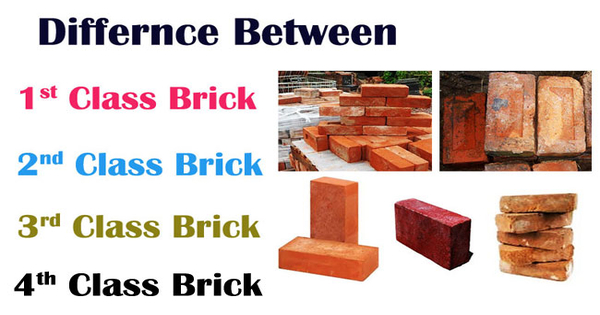Introduction of bricks & their types

Introduction of Bricks
- Brick is most ancient and most recognized building materials.
- To develop brick, mould clay in square type blocks with identical sizes and then dry & burn these blocks.
- Standard size of bricks vary from 190mm.*90mm.*90mm. Or 200mm.*100mm.*100mm.(with mortar)
- Standard size -230mm.*110mm.*110mm. Or 230mm.*110.*75mm
- Weight of a single brick belongs to 3.5Kg. (Approx)
Categorization of Bricks
1. Unburnt Bricks
- The heat generated from sun light is used to dry these bricks as soon as the moulding process is completed.
- The bricks are mostly found in temporary and low-priced construction work.
2. Burnt Bricks
- Once moulding and drying process are finished, these bricks are burnt in a clamp or kiln.
- These bricks are solid, strong, long lasting and applicable in permanent construction works.
- These Bricks divided into 4 categories:- a) First Class Brick, b) Second Class Brick, c)Third Class Brick, d)Fourth Class Brick.
a) First Class Brick
- The bricks are moulded through table
- Properly burnt and regular in shape and size.
- Edges are piercing and properly demarcated.
- Consistent in colour.
- Water absorption capacity should not surpass 20%
- Lowest crushing strength is similar to 0.5 N/mm2.
Applications of First Class Brick
- For pointing and uncovered face work.
- Flooring and reinforced brick work.
b) Second Class Brick
- These are moulded in ground
- Perfectly burnt and the shape and size are uneven.
- Edges are neither straight nor properly demarcated.
- Inconsistent in colour.
- Water absorption capacity does not surpass 22%
- Lowest crushing strength=7 N/mm2.
Applications of Second Class Brick
- Concealed masonry work enclosed with plaster.
- Centering of reinforced brick work.
c) Third Class Brick
- It is moulded in ground
- Under-burnt and shape and size are inconsistent.
- Light yellowish The colour is light yellow.
- Edges are asymmetrical.
- Water absorption capacity does not surpass 25%
- Lowest crushing strength is 3.5 N/mm2.
Applications of Third Class Brick
- Mostly useful for temporary building structure.
d) Fourth Class Brick
- Burnt excessively.
- Uneven in shape and size.
- Colour is gloomy.
- Solid and well-built.
Applications of Fourth Class Brick
- Ballast of such bricks are applied for foundation and floor.

